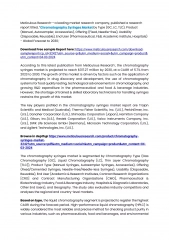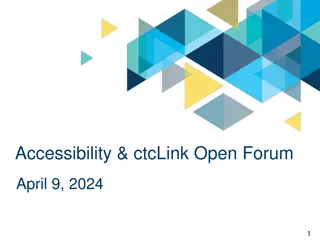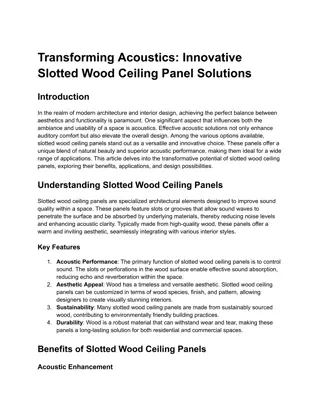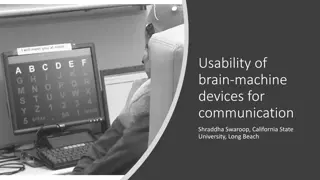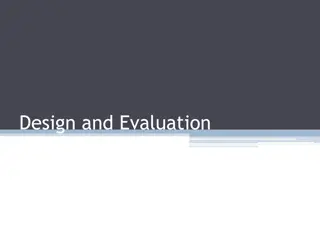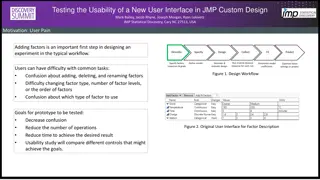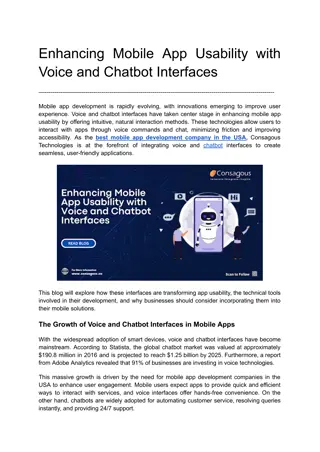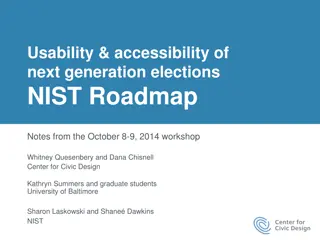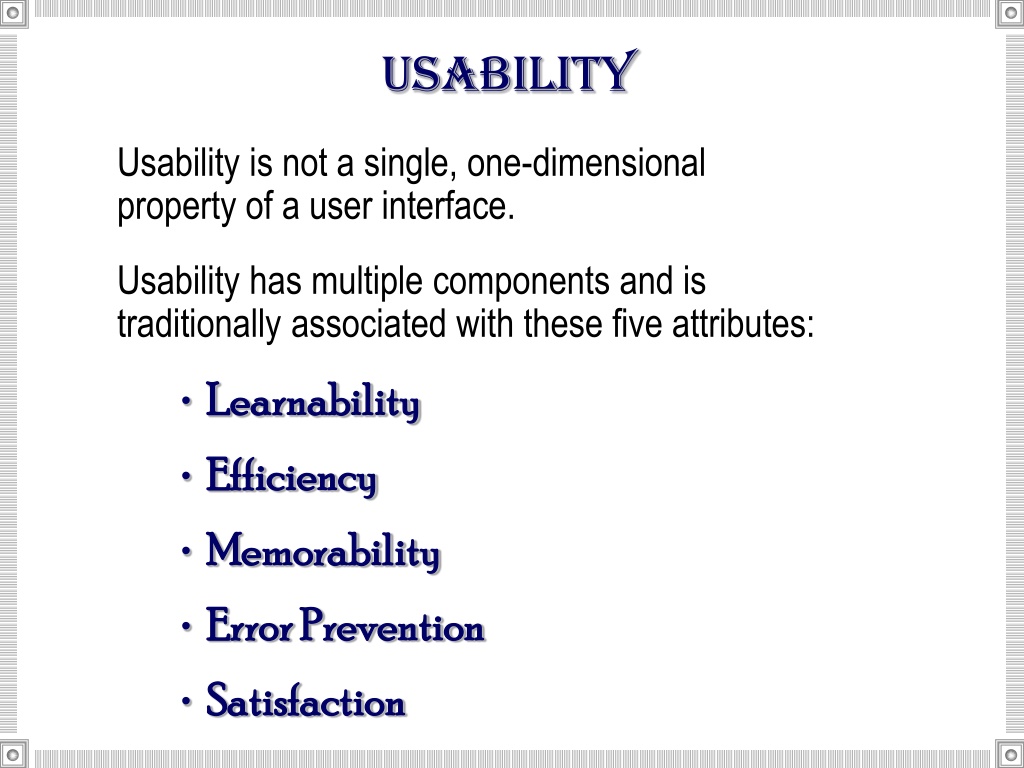
Understanding Usability Engineering Lifecycle Components
Learn about the multiple components of usability and the importance of incorporating usability activities throughout the product lifecycle. Explore key attributes like learnability, efficiency, memorability, error prevention, and satisfaction in usability engineering. Discover the significance of usability testing with real users for effective product design.
Download Presentation

Please find below an Image/Link to download the presentation.
The content on the website is provided AS IS for your information and personal use only. It may not be sold, licensed, or shared on other websites without obtaining consent from the author. If you encounter any issues during the download, it is possible that the publisher has removed the file from their server.
You are allowed to download the files provided on this website for personal or commercial use, subject to the condition that they are used lawfully. All files are the property of their respective owners.
The content on the website is provided AS IS for your information and personal use only. It may not be sold, licensed, or shared on other websites without obtaining consent from the author.
E N D
Presentation Transcript
Usability Usability is not a single, one-dimensional property of a user interface. Usability has multiple components and is traditionally associated with these five attributes: Learnability Learnability Efficiency Efficiency Memorability Memorability Error Prevention Error Prevention Satisfaction Satisfaction
The Usability Engineering Lifecycle UE is not a one-shot affair where the user interface is fixed up before release of the product. UE is a set of activities that ideally take place throughout the lifecycle of the product, with significant activities happening at the early stages before the user interface has even been designed. UE can still be successful even if it does not include every possible refinement at all of the stages.
The Usability Engineering Lifecycle The lifecycle model emphasizes that one should not rush straight into design. The least expensive way for usability activities to influence a product is to do as much as possible before design is started, since it will then not be necessary to change the design to comply with the usability recommendations.
The Usability Engineering Lifecycle However, any test or evaluation, at any time in the development lifecycle is much better that none at all !!!
Usability Usability Testing Testing & & The Test Plan The Test Plan 5
Usability Testing Usability Testing User testing with real users is the most fundamental usability method. In some sense irreplaceable, since it provides direct information about how people use computers and what their exact problems are with the concrete interface being tested. As in all kinds of testing one needs to pay attention to the issues of reliability and validity.
Usability Testing Usability Testing Reliability is the question of whether one would get the same result if the test were to be repeated. A problem because of the huge individual differences between test users Validity is the question of whether the result actually reflects the usability issues one wants to test. Whether the test in fact measures something of relevance to usability of real products in real use outside the laboratory. Whereas reliability can be addressed with statistical tests, a high level of validity requires methodological understanding of the test method one is using as well as some common sense.
The Test Plan Suggested Format Suggested Format Purpose Research Questions Participant characteristics Method (test design) Task list Test environment / equipment Test moderator role Evaluation measures (data to collect) 8
Purpose High level description of the reason for performing the test at this time. You want to determine if both of your major customers can use the product equally well. You want to know whether or not the documentation is able to compensate for some acknowledged problems with the interface. You have received numerous complaints associated with using the control panel. You are interested in determining the exact nature of the problem and how you will fix it. 9
Research questions Research questions Most important section, because it describes the issues and questions that need to be resolved. They should be as precise, accurate, clear, and measurable. Without a clear Research Questions (objectives), you might find yourself in the unenviable position of conducting a wonderful test that neglects to answer the key concern of developers on the project team. Or, you might find yourself with a test submerged in controversy because no one can agree on what to test. 10
Research questions Research questions Examples of unfocused and vague research questions: Is the product usable? Is the product ready for release or does it need more work? These questions are incomplete and vague. They neither state nor imply how to measure or quantify the results. A test based on these questions will invariably bias the results favorably. 11
Research questions Examples Research questions Examples - - Web Sites Web Sites How easily do users understand what is clickable? How easily and successfully do users find the products or information they are looking for? How easily and successfully do users register? Where in the site do users go to find Search? Why? How easily can users return to the home page? 12
Research questions Examples Research questions Examples- - Small Interfaces Small Interfaces How easily do users switch between modes on multi- purpose buttons? How well do users understand the symbols and icons? Which ones are problematic? Why? How easily do users download updates and features? How quickly can users perform common tasks? 13
Research questions Examples Research questions Examples - - Software Software How closely does the flow of the software reflect how the user thinks of the work flow? How easily and successfully do users find the tools or options they want? Do users use the toolbar icons or the standard menus? Why? Is the response time a cause of user frustration or errors? 14
Research questions Examples Research questions Examples - - General General What obstacles prevent users from completing installation and set up? Can users perform common tasks within established benchmarks? What are the major usability flaws that prevent users from completing the most common tasks? How does ease-of-use compare between our product and the competition? Is there an appropriate balance of ease of use and ease of learning? 15
Example Example Overall objectives for the study We will gather baseline data about the overall effectiveness of www.H.com. The goals of this study are to: Assess the overall effectiveness of www.H.com for different types of users performing basic, common tasks. Identify obstacles to completing room reservations on the site. Create a repeatable usability study protocol. Research questions In addition, in this study will try to answer these questions: How easily and successfully do travelers get started with making a reservation on the site? Does the starting point make any difference in whether travelers are successful in reaching their goal on H.com? If so, what are the differences? 16
Example Example Research questions What paths do travelers take to completing a booking? How well does the site support the paths and goals of the travelers? That is, how closely does the organization and flow of the site match travelers expectations? What obstacles do travelers encounter on the way to completing a booking, whether using a credit card or rewards? What questions do travelers ask as they work through their reservation? How do travelers feel about how long it takes them to complete an online booking, both the perceived of time and the number of steps? 17
Summarize Participant Characteristics Summarize Participant Characteristics Describes the end user(s) of the product to be tested It is important to work closely with marketing to determine the target population One thing to remember when describing the participant characteristics is to use the right number of participants. When it comes to selecting the number of participants to employ for a test, the overriding guideline is You cannot have too many participants. 18
Method Method (Test Design) Description of how your are going to carry out the research. Betweeen Subjects: Each part is tested by a unique set of users. Whithin Subjects: Same set of users tests all parts. Potential problem of transfer of learning effects. Mitigate the effects by using counterbalancing. If you are not confident that you can conduct a test with experimental rigor, then by all means keep the test simple. The more straightforward the test, the easier it is to keep everything consistent from session to session. Better to attain meaningful results from a smaller, simpler study than to acquire a wealth of meaningless data from a larger study. 19
Guidelines For Ensuring Experimental Rigor Guidelines For Ensuring Experimental Rigor 1. Employ and adequate number of participants 2. Be consistent Use scripts, checklists, have the same monitor for all tests, if possible 3. Confirm the characteristics of your participants 4. Note any unusual problems with the test 5. Have specific goals and objectives in mind 6. Conduct a pilot test 7. Keep it simple 8. Make the testing environment as realistic as possible 20
Pilot Test Pilot Test No usability testing should be performed without first having tried out the test procedure on a few subjects. Often, one or two pilot subjects will be enough, but more may be needed for large tests or when the initial pilot tests show severe deficiencies in the test plan. The first few pilot subjects may people who are easily available to the experimenter; but at least one should from the same pool as the other test users. During pilot testing, one will typically find That instructions for a tasks are incomprehensible to the users or that they misinterpret them. A mismatch between the test tasks and the time planned for each test session.
Pilot Test Pilot Test Pilot testing can also be used to refine the experimental procedure and to clarify the definitions of various things that are to be measured. For example, it is often difficult to decide exactly what constitutes a user error or exactly when the user can be said to have completed a given test task. The pilot test may reveal inconsistencies or weaknesses in the definitions contained in the test plan. The pilot test also helps to determine if the length of the test is appropriate, difficulties, surprises, etc.
Task List Tasks the participants will perform during the test. In the early stages of developing the test, the list description is intended for members of the team. You don t need too much detail. Later, you will expand the tasks into full-blown scenarios will realistic details and context that will enable participants to perform tasks with little intervention. 23
Test Tasks Test Tasks Basic rule: chose tasks to be as representative as possible of the users to which the system will eventually be put in the field. Provide reasonable coverage of the most important parts of the User Interface. Tasks should be small enough to be completed within the time limits of the user test, but not so small that they become trivial. Specify precisely what result the user is being asked to produce. Example: Spreadsheet tasks Enter sales figures for six regions for each of the four quarters (sample numbers given) Obtain totals and percentages Construct a bar chart showing trends across regions 1. 2. 3.
Test Tasks Test Tasks Test tasks should never be frivolous, humorous, or offensive (mustache president) All tasks should be business-oriented and as realistic as possible The tasks can also be used to increase the user s confidence. The first task should always be extremely simple to guarantee an early success experience. Tasks are normally given to users in writing (paper or computer window). Allow users to ask questions about the tasks in order to minimize the risk of misinterpretation.
Task List What to Include What to Include A brief description of the task (one line) The materials and machine states required to perform the task. Context is everything Simulate machine states Provide drafts of the screens Load files into screen Screens to navigate A description of successful completion of the task. Benchmarks that establish the max time limits (optional) 26
Tips on Developing The Task List The trick is to indirectly expose usability flaws by having the participants perform tasks that use the parts of the product in question. Suppose you wanted to test how easy it is to understand a label for a tab that appears on an image-sharing web site. Establish whether users can understand the meaning of the XYZ label. There are six tabs with text labels on the web site, but the XYZ label is the problematic one. It s called Organize. If you simply take the objective at face value you might decide to have the task: Show the participants the XYZ label and have them explain its meaning to you. 27
Tips on Developing The Task List - Example Example However, there are actually three discrete processes associated with using the label correctly. 1. Noticing the Label 2. Reading the Label 3. Processing the info and responding correctly These three processes occur within the very specific context of using the web site to post images on the web. If you simply show the participants the label, you only address the second and third processes. You will also negate the entire context (When using the web site, the users will perform a task at the time when they are supposed to, not having someone point out the label and ask them what they think) 28
Tips on Developing The Task List - Example Example Instead, you have to provide a task during which they are expected to use the label, and ascertain whether they notice, read, and use the label correctly. Arrange images into collections. The label usage is explored indirectly by the test moderator while the task is performed. 29
Tips on Developing The Task List It is very rare when you can actually test the full range of tasks the comprise an entire interface. When choosing this sample of tasks, it is important that you exercise as many of the most important aspects of the product as possible and address all test objectives. Prioritize by frequency (Tasks most frequently performed) Prioritize by criticality Prioritize by vulnerability Tasks that you suspect will be hard to use or have design flaws Prioritize by readiness 30
The Task Scenarios Representations of actual work that users would conceivably perform with the product. Expanded versions of the original task list, adding context and the participant s rationale and motivation to perform those tasks. In many cases, a scenario will comprise several task. Task scenarios should describe: The end results that the user will try to achieve. Motives for performing the work. Actual data and names rather than generalities. The state of the system when a task is initiated.
The Task Scenarios - Guidelines 1. Provide realistic scenarios, complete with motivations to perform (explicit or implicit). The closer they represent reality, the more reliable the test results. Participants will find it easier to stay in role and overcome any hesitation and self-consciousness if the scenarios reflect familiar situations, with realistic reasons for performing the tasks. 2. Sequence the scenarios in the order that they are most likely to be performed. Retain the illusion of authenticity Guide users in approximately the same way they would learn on the job Expose the snowballing effects of errors and misconceptions. If order is not crucial, consider counterbalancing.
The Task Scenarios - Guidelines 3. Try to provide a substantial amount of work in each scenario. Do not guide the users through the product piecemeal Provide a goal and let users do the rest. Ex: Using this web site, you want to send some books to your nephew for his birthday To accomplish the task, it is implied that the users must either learn or exhibit the following skills Search for and select books. Review the list of items being ordered. Enter the recipient s address. Specify the appropriate billing address. Whether user can perform or figure out these intermediate steps in order is precisely what you want to learn form the test.
The Task Scenarios - Guidelines If you simply ask them to search for and select books and then fill out the addresses needed, . . . you never see whether the participants can put it all together, as they must on the job. Your tasks should force the users to exhibit their conceptual understanding of the product, . . . and expose their misunderstandings about how to use it.
Give Participants the Tasks to Do Reading Task Scenarios to the Participants Letting the Participants Read Task Scenarios Themselves
Evaluation Measures (Data To Collect) Provide an overview of the types of measures to be collected, performance and preference data. Data to be collected should be based on the test objectives. A major pitfall with respect to measurement is the potential for measuring something that is poorly related to the property one is really interested in assessing. 36
Sample Performance Performance Measures Time to complete each task. Number and % of tasks completed correctly with/without assistance Number and percentage of tasks completed incorrectly Time required to access info in manual or help Time required to recover from errors Count of all incorrect selections (errors) Count of errors of omissions Count of incorrect menu choices Count of visits to the index., site map, help, etc. 37
Sample Preference Preference Measures Ratings and rationale concerning: Usefulness of the product How well product matched expectations Appropriateness of product functions to user s tasks Ease of use overall Ease of learning overall Ease of setup and installation Usefulness of the index, help, graphics, This product vs. a competitor s product Examples of Quotable quotes: I loved it when can I get one You guys are not listening to customers 38
Data Collection Tools Before collecting data, you need to consider the following basic questions: What data will address the problem statement(s) in your plan? How will you collect the data? How will you record the data? How do you plan to reduce and analyze the data? How and to whom will you report the data? What resources are available to help with the entire process? 1. 2. 3. 4. 5. 6. The answers will drive the development of the instruments, tools, and even the number of people required to collect the data. Data collection should never be a hunting expedition, where you collect info first, and worry about to do with it later. An imprecise approach typically results in an unwieldy amount of data to reduce and analyze, and tends to confuse more than enlighten. o
Information to Collect - Example How effective is a tutorial in teaching a specific task? Time expired between accessing the tutorial and successful completion of the task, or Comparison of error rates of participants using and not using the tutorial
Information to Collect - Example How easy is it to perform a specific task using a new hardware-based product? Error rate among all participants, or Number of steps required to perform the task
Information to Collect - Example Do novice users access the site map? Number of unsolicited accesses of the site map before completing the task, and Explanations of what participants were looking for in the navigation categories that they did not find
Data Collection Tools o On-Line Data Collection o Manual collection o Data loggers
6.4 6.4 Ethical Aspects of Tests with Human Subjects Ethical Aspects of Tests with Human Subjects Users feel a tremendous pressure to perform, even they are told that the purpose of the study is to test the system and not the user. Users will inevitably make errors and be slow at learning the system, and they can easily get to feel inadequate or stupid as they experience these difficulties. Knowing that they are observed, or recorded, makes the feeling of performing inadequately even more unpleasant to the users. Same for all users (highly educated, professionals,./..) The experimenter must make the users feel as comfortable as possible during and after the test. They must never laugh at the users or make in any comments regarding their performance.
6.4 6.4 Ethical Aspects of Tests with Human Subjects Ethical Aspects of Tests with Human Subjects During the introduction, the experimenter should make clear that it is the system that is being tested and not the user . Test users should never be referred to as "subjects," "guinea pigs," or other such terms. (test user, participant) Users should be told that no info about the user s performances will be revealed (specially not to their managers). The test should be conducted in a relaxed atmosphere, take the time for small talk to calm down (before start, in breaks). If the test takes more than an hour or so, serve something . . .
6.4 6.4 Ethical Aspects of Tests with Human Subjects Ethical Aspects of Tests with Human Subjects To bolster the users' confidence and make them at ease, the very first test task should be so easy that they are virtually guaranteed an early success experience. Ensure that everything (room, computer, test software, copies of test tasks, questionnaires) is ready before the test user arrives. The test session should be conducted without disruptions. Test results should be kept confidential, and written in such a way that individual test users cannot be identified. The test should be conducted with as few observers as possible, since the size of the "audience" also has a detrimental effect on the test user
6.4 6.4 Ethical Aspects of Tests with Human Subjects Ethical Aspects of Tests with Human Subjects During testing, the experimenter should normally not interfere with the user but should let the user discover the solutions to the problems on his or her own. On the other hand, the experimenter should not let a user struggle endlessly with a task if the user is clearly bogged down and getting desperate. In such cases, the experimenter can gently provide a hint or two to the user in order to get on with the test. The experimenter may have to terminate the test if the user is clearly unhappy and unable to do anything with the system (desperate cases only) Test users should be informed before starting that they can always stop the test at any time.
6.4 6.4 Main Ethical Considerations for User Testing Main Ethical Considerations for User Testing Before the test: Have everything ready before the user shows up. Emphasize that it is the system that is being tested, not the user. Acknowledge that the software is new and untested, and may have problems. Let users know that they can stop at any time. Explain any recording, keystroke logging, or other monitoring that is used. Tell the user that the test results will be kept completely confidential. Make sure that you have answered all the user's questions before proceeding.
6.4 6.4 Main Ethical Considerations for User Testing Main Ethical Considerations for User Testing During the test: Try to give the user an early success experience. Hand out the test tasks one at a time. Keep a relaxed atmosphere in the test room, serve coffee and/or have breaks. Avoid disruptions: Close the door and post a sign on it. Disable telephone. Never indicate in any way that the user is making mistakes or is too slow. Minimize the number of observers at the test. Do not allow the user's management to observe the test. If necessary, have the experimenter stop the test if it becomes too unpleasant.
6.4 6.4 Main Ethical Considerations for User Testing Main Ethical Considerations for User Testing After the test: End by stating that the user has helped you find areas of improvement. Never report results in such a way that individual users can be identified. Only show videotapes outside the usability group with the user's permission.


